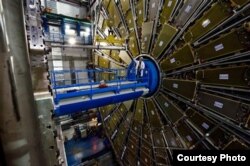It can't be seen with the naked eye, and it requires the power of the world's largest and most complex machine to find it. Yet it could change the very understanding of the known world of particle physics.
Right now, though, it's simply a "bump."
"In particle physics, a bump is when you have a smooth data curve — which is what you expect — and you see a little excess, a little bump in the middle of it, and that often is indicative that you may have made a discovery of some kind," said scientist Don Lincoln.
He's one of hundreds of scientists and researchers at Fermilab in suburban Chicago reviewing the data produced by experiments at the European Organization for Nuclear Research, or CERN, facility in Switzerland, which is home to the world's most powerful particle accelerator, the Large Hadron Collider, also known as the LHC.
"Since about 1964," Lincoln explained, "we have invented a series of theories that, blended together, is called the Standard Model of Particle Physics and from that we can explain all data that we've taken. However, we can't explain this bump."
Which means this "bump" could represent a new particle previously unknown to scientists, and could fundamentally change understanding of particle physics.
"If it is real, it's probably the biggest discovery of the last half century," Lincoln said.
Then again, he adds, maybe it isn't.
"It could be a discovery, or it could go away. It's in that sort of gray area," he added.
Long-distance collaboration
Fermilab, where Lincoln and other scientists sort through that gray area, is the home of the Tevatron accelerator, once the largest superconducting supercollider in the world. Though the Tevatron accelerator has been taken offline, and has been eclipsed by CERN's LHC, Fermilab remains at the forefront of particle physics.
"We bring a certain amount of technology, know-how, to their machine because we started with a superconducting machine. So we have viable knowledge to bring to the table," said Fermilab's director, Nigel Lockyer.
Although the United States is one of the largest national collaborators for experiments conducted with the LHC in Switzerland, Lockyer noted that particle physics is now a more global exercise.
"We're into a new era of relationship between CERN and Fermilab, or between the United States and Europe, intertwining our particle physics programs," he said.
What helps the interaction are technological advances and global cooperation that allow scientists at Fermilab to remotely monitor and analyze data produced by the LHC's particle collisions some 7,000 kilometers away.
Everything, or nothing
As the particle collisions continue to produce data, Lincoln says the watchful eyes of more than a thousand scientists globally will arrive at one of two explanations for the "bump."
"One is that this is just a random statistical fluctuation and it will disappear with more data, and we need to be very clear about that," he explained. "The far more exciting possibility is that if it is real, yes, absolutely it is a completely fascinating thing that will rewrite our understanding of how the world works."
The LHC starts a six-month run of proton-smashing collisions, which is expected to produce six times the amount of data previously available to scientists.
Somewhere in that data may lie the answers scientists are looking for either to prove the existence of a new particle, or allow them to dismiss the "bump" as nothing more than a bump in the road to better understanding the Standard Model of Particle Physics.












